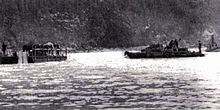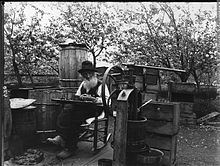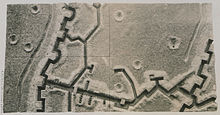Edwin Tappan Adney
Edwin Tappan Adney (born July 13, 1868 in Athens , Ohio , † October 10, 1950 in Woodstock ) was a Canadian artist, writer, ethnologist and photographer. He was particularly interested in building models of birch bark canoes used by the Canadian natives. He built over 120 models of canoes, which are now in the Mariners' Museum in Newport News , Virginia. His experiences during the Klondike gold rush , in which he participated as a newspaper correspondent, he described in the book The Klondike Stampede .
Life
Edwin Tappan Adney was born in Athens, Ohio in 1868 as the son of William Harvey Glenn Adney (born April 23, 1834 in Vinton, Gallia County, Ohio; † June 23, 1885, Gum Spring Plantation near Pittsboro, North Carolina), a professor at the university Ohio , and his wife Ruth Clementine Shaw Adney († October 29, 1911 in Pittsboro, North Carolina). When Adney was five, the family moved to Washington, Pennsylvania, where his father taught at Washington and Jefferson College. In 1879, his father left college for health reasons and bought Gum Spring Plantation, a tobacco farm near Pittsboro, North Carolina.
As a boy he was tutored in science, math, history, English literature, and Latin by his father, who tutored students. At thirteen, Adney completed two years at the University of North Carolina at Chapel Hill .
After their parents separated, his mother moved to New York City with him and his one year younger sister Mary Ruth in 1883 to give the children a better education. In order to earn a living, his mother ran a pension there. Adney attended Trinity School. After graduating from high school, he worked in a law firm during the day and took drawing lessons at the Art Students League (ASL) in the evening . At this time Adney met his future wife Minnie Bell Sharp from Woodstock, New Brunswick , Canada, who received a vocal and piano training in New York and lived in his mother's boarding school.
In 1887, Adney and his sister Minnie Bell visited Sharp's family in Woodstock. Adney planned to spend a month here preparing for Columbia College entrance exams. In Woodstock, however, he met Peter Joseph, a canoe maker of the Malecite Indians . This sparked his interest in the culture of the Malecite Indians and especially in the construction of the traditional birch bark canoes, and he began to draw the canoes. Adney eventually stayed in Woodstock for 20 months, began learning the Malecite language and, with Peter Joseph's help, built his first canoe model. In 1890 he published a treatise on canoe building in Harper's Young People Supplement.
From 1890 Adney earned his living as a freelance writer and illustrator for various magazines; His contributions have appeared in Harper's Weekly , Collier's Weekly , Harper's Young People , Saint Nicholas , Outing, and Our Animal Friends . In 1895 he made 100 drawings for the Handbook of Birds of Eastern North America , an ornithological identification book that was very common in the USA and Canada until the 1920s.
In 1897 and 1898 Adney took part in the Klondike gold rush on the Yukon River as a correspondent for Harper's Weekly and the London Chronicle for 16 months . In 1900 he published the book The Klondike Stampede , which is illustrated with his numerous photographs and drawings. In 1900 he also reported on the Cape Nome gold rush as a correspondent. During these trips, he deepened his interest in the culture of the native Canadian people.
In 1899 Adney married the musician Minnie Bell Sharp. The couple had a son in 1902, Francis Glenn Adney (born July 9, 1902 in Woodstock, New Brunswick). Like his mother, he became a musician, but achieved little fame as a jazz pianist in the USA.
From 1902 to 1916 Adney lived alternately in New York and Woodstock. His father-in-law Francis Peabody Sharp's nursery had run into financial difficulties, and Adney and his wife struggled in vain to rebuild the business. 1916 Adney joined the Canadian Expeditionary Force , where he with the rank of lieutenant in the unit of the Royal Canadian Engineers World War served. However, he did not take part in any foreign deployment, but designed true-to-scale models of defensive trenches for the Royal Military College.
In 1917 Adney became a Canadian citizen. After the war, Adney moved to Montreal , where he earned his living as a coat of arms painter and carver. In 1926 he made 36 carved coats of arms for the Chateau Frontenac Hotel in Quebec . The series shows the coats of arms of all French and British governors between 1604 and 1926. The coats of arms are still on display in the hotel's Champlain Dining Room.
In a 1926 competition for the design of the national flag of Canada by La Presse magazine in Montreal, his design won, but was ultimately not implemented.
He was still interested in canoe building and the culture of the American and Canadian natives. He continued to build canoe models and wrote a book about canoe construction, but could not find a publisher. When he got into financial hardship, he had to pledge his canoe collection, which includes 110 1: 5 scale models, to the Strathcona Ethnological Museum at McGill University in Montreal in 1928 . Since he was unable to repay his debts, the collection became the property of the museum in 1939.
In 1933 he left Montreal to care for his sick wife, who died in 1937.
Through Fred Hill's mediation, the Mariners' Museum paid Adney's debts to McGill University in 1940 and acquired the canoe collection. In addition, the Mariners' Museum awarded Adney a monthly grant of $ 100 to continue working on his book on canoe building. The museum stopped paying in 1947 after it was discovered that Adney had stopped working on the book after a year.
Adney campaigned for the rights of the Malicete Indians and the preservation of their culture and traditions. Together with Dr. Peter Paul, a close friend of the Woodstock First Nation, Adney spent 15 years working on a grammar dictionary for the Mailseet language, but it was never published.
Adney died in Woodstock on October 10, 1950 without finishing any book.
Immediately after Adney's death, his son, Glenn Adney, gave the Mariners' Museum the material that Adney had collected on canoeing throughout his life; the material on the ethnology of the American natives, linguistics and heraldry went to the Peabody Essex Museum. Other parts of the estate went to the University of New Brunswick, Dartmouth College and the Carleton County Historical Society.
In 1952, the Mariners' Museum planned to publish the material in a book and commissioned Howard Chapelle to review the estate; the project was however initially interrupted after the sudden death of the museum president Homer Ferguson. At Chapelle's initiative, the project was finally resumed; In 1964 the book was published by the Smithsonian Institution .
Publications
- How an Indian Birch-bark Canoe is Made.
- Some New Brunswick Trap. in: Forest and Stream . January 5, 1893
- The Klondike Stampede. Harper & Brothers , New York 1900
- The Malecite Indians' Names for Native Berries and Fruits, and Their Meanings. in: The Acadian Naturalist , May 1944
- posthumously with HI Chapelle: The Bark Canoes and Skin Boats of North America. Smithsonian Institution Press , Washington 1964
Individual evidence
- ^ CT Behne: The Travel Journals of Tappan Adney 1887-1890. Goose Lane Editions, Fredericton, 2010, ISBN 978-0-86492-628-9 , p. 14
- ↑ a b Michael Gates: The naked truth about Tappan Adney , on Yukon News, accessed May 25, 2014
- ^ CT Behne (2010) The Travel Journals of Tappan Adney 1887-1890 . Goose Lane Editions, Fredericton, ISBN 978-0-86492-628-9 , p. 13
- ↑ Frank Michler Chapman: Handbook of birds of eastern North America
- ↑ http://www.tappanadney.com/ , accessed May 24, 2014
- ^ C. Mary Young, "Sharp, Francis Peabody," in Dictionary of Canadian Biography, vol. 13, University of Toronto / Université Laval, 2003; accessed on May 25, 2014
- ↑ Archive link ( Memento of the original from December 25, 2013 in the Internet Archive ) Info: The archive link was inserted automatically and has not yet been checked. Please check the original and archive link according to the instructions and then remove this notice. , accessed May 24, 2014
- ↑ Review publicized to ET Adneys at Goose Lane diary, accessed on May 25, 2014
- ↑ Archive link ( Memento of the original from December 25, 2013 in the Internet Archive ) Info: The archive link was inserted automatically and has not yet been checked. Please check the original and archive link according to the instructions and then remove this notice. , accessed May 24, 2014
- ↑ Archive link ( Memento of the original from December 25, 2013 in the Internet Archive ) Info: The archive link was inserted automatically and has not yet been checked. Please check the original and archive link according to the instructions and then remove this notice. , accessed May 24, 2014
- ^ CT Behne: The Travel Journals of Tappan Adney 1887-1890. Goose Lane Editions, Fredericton, 2010, ISBN 978-0-86492-628-9 , p. 16
- ↑ The Edwin Tappan-Adney Papers ( Memento of the original from October 20, 2013 in the Internet Archive ) Info: The archive link was inserted automatically and has not yet been checked. Please check the original and archive link according to the instructions and then remove this notice. from the Mariners' Museum home page in Newport News, accessed May 24, 2014
- ↑ James W. Wheaton: Tappan Adney's Maliseet Studies: More Than Canoes. Paper presented at the 34th Algonquian Conference for Language and Linguistics at Queen's University, Kingston, Ontario. 2002; Retrieved May 25, 2014
| personal data | |
|---|---|
| SURNAME | Adney, Edwin Tappan |
| ALTERNATIVE NAMES | Adney, Tappan |
| BRIEF DESCRIPTION | Canadian artist, writer, ethnologist and photographer |
| DATE OF BIRTH | July 13, 1868 |
| PLACE OF BIRTH | Athens, Ohio |
| DATE OF DEATH | October 10, 1950 |
| Place of death | Woodstock |





